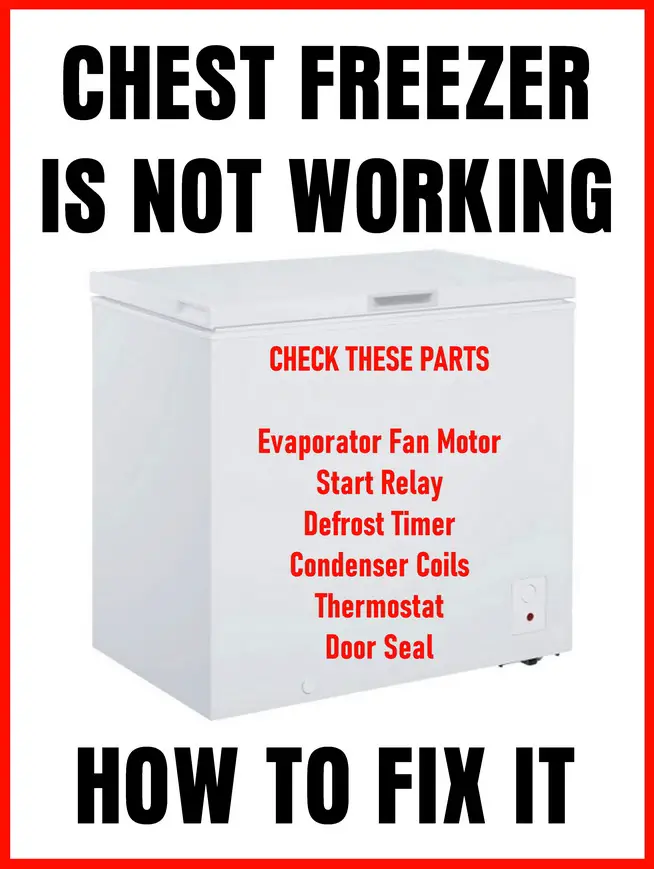Chest freezer not freezing food? When your chest freezer stops working, you will need to identify and fix the issue to prevent food spoilage. Various parts can be responsible for a malfunctioning chest freezer. Understanding these 7 main parts and how to address their issues can help you get your freezer not freezing to freeze again.

Breaking down the potential issues into individual components can make it easier for you to quickly identify the problem with the freezer:
- Evaporator Fan Motor: If this motor fails, it can lead to uneven cooling in the freezer as it’s responsible for circulating cold air.
- Start Relay: This part aids the compressor’s operation. A malfunctioning start relay can prevent the freezer from cooling properly.
- Defrost Timer: It manages the defrost cycle to prevent frost buildup. If faulty, it can cause blocked airways due to excessive frost.
- Condenser Coils: If these coils are dirty, they can’t release heat efficiently, impacting the freezer’s cooling ability.
- Thermostat: This regulates the freezer’s temperature. A failure here can result in the freezer being too cold or not cold enough.
- Door Seal: A damaged or dirty door seal can let cold air escape, forcing the freezer to work harder to keep the contents cold.
- Compressor: If the compressor is not working properly, the freezer will not cool at all.
1. Evaporator Fan Motor: Essential for Air Circulation
The evaporator fan motor is key in your freezer. It moves cold air from the coils throughout the freezer, ensuring everything stays frozen.
A non-functioning fan motor means the freezer may not cool effectively. This could be due to a burnt-out motor or blockage in the fan blades. You might notice unusual noises if the fan is struggling.
To address this, disconnect the freezer’s power and inspect the fan for obstructions. If the motor appears damaged or unresponsive, replacing it according to your freezer’s manual can resolve the issue.
2. Start Relay: Critical for Compressor Function
The start relay assists the compressor, vital for circulating refrigerant and maintaining cold temperatures in the freezer.
A faulty start relay can prevent the compressor from functioning, leading to a warm freezer. Indicators of a malfunctioning start relay include a humming noise or the freezer starting and stopping abruptly.
To fix this, locate the start relay on the compressor, remove it, and test for continuity with a multimeter. If defective, replace it with a new one, ensuring it’s correctly installed.
3. Defrost Timer: Controls the Defrost Cycle
The defrost timer is responsible for preventing excessive frost by periodically activating the defrost heater. It prevents frost from clogging the evaporator coils.
A malfunctioning defrost timer can lead to frost accumulation, obstructing airflow and reducing cooling efficiency. Symptoms include an overly warm freezer or excessive frost.
You can try advancing the timer manually to trigger the defrost cycle. If this doesn’t work, replacing the timer is likely necessary, following your freezer’s specific guidelines.
4. Condenser Coils: Need to Be Clean for Efficiency
Condenser coils, responsible for dissipating heat, are crucial for freezer operation. Located typically at the back or bottom, these coils need to be clean to function effectively.
Dirty coils can’t release heat efficiently, impacting the freezer’s cooling ability. This is often evidenced by a poorly cooled freezer.
Cleaning these coils can greatly improve performance. After unplugging the freezer, locate the coils and clean them thoroughly with a brush or vacuum, removing all dust and debris.
5. Thermostat: Regulates the Freezer’s Temperature
The thermostat is the temperature regulator in your freezer. It signals the compressor to maintain the desired temperature.
A defective thermostat can result in a freezer that is either too cold or not cold enough. Adjusting the thermostat might not yield any change in such cases.
If adjusting the thermostat doesn’t rectify the temperature issue, you may need to replace it. Purchase a suitable thermostat and install it as directed in your freezer’s manual.
6. Door Seal: Vital for Maintaining Cold Air
The door seal, or gasket, ensures cold air retention inside the freezer. A compromised seal can lead to warm air ingress and cold air escape, overworking the freezer.
Issues with the door seal can include cracks, looseness, or dirt, all of which hinder its effectiveness. Signs of a failing door seal include frost near the door or noticeable cold air leakage.
Resolving door seal problems typically involves cleaning the seal with mild detergent or, if damaged, replacing it with a new seal, following the manufacturer’s instructions.
7. Freezer Compressor: Heart of the Cooling System
The compressor is the heart of your freezer’s cooling system. It circulates refrigerant to generate cold air. If the compressor is not working properly, the freezer will not cool at all. Symptoms of a failing compressor include unusual noises or the freezer not maintaining its temperature.
Repairing a compressor can be complex and may require professional assistance. However, ensuring that the compressor’s surroundings are clean and well-ventilated can sometimes improve its performance.
How to Quickly Identify Freezer Issues
When a freezer stops freezing, the evaporator fan motor might stop operating leading to uneven cooling. The start relay the part for starting the compressor, could fail and prevent cooling.
The defrost timer, runs the frost prevention cycle, may malfunction, causing frost to clog the air passages. If the condenser coils, responsible for heat expulsion, become dirty, they mess up the freezer’s cooling capabilities. The thermostat, overseeing the internal temperature, might malfunction, causing either excessive or insufficient cooling.
A bad door seal, due to damage or grime, can lead to cold air leakage, forcing the freezer to run excessively to maintain the desired temperature. Issues with the compressor itself, the core of the cooling system, can lead to significant cooling problems, as it’s responsible for circulating the refrigerant necessary for producing cold air.
Need more help? Please leave a comment below and an experienced appliance repair technician will find you a solution.



Leave a Reply